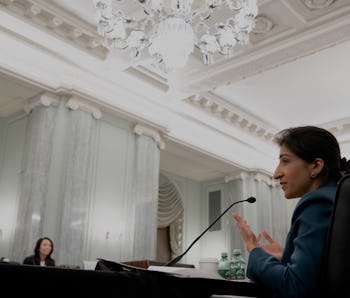A TAX BAKUNIN SUPPORTED
Stronger estate tax would hit
more inheritances under
Democrats' plan
A historic low number of estates paid taxes in 2020, underscoring how much that tax has weakened in the last two decades. But Democrats are looking to change that as part of their tax hikes targeting the wealthy.
Democratic lawmakers want to tax estates worth $5.85 million or more — reverting back to the same exemption amount as in 2017. Currently, only estates worth $11.7 million are taxed. The move would subject more estates to the tax starting next year.
“Estate taxes have basically been gutted over the last couple of decades,” Samantha Jacoby, senior tax legal analyst at the Center on Budget and Policy Priorities, told Yahoo Money. “It’s easy to plan around. It's easy for wealthy people with sophisticated advisers to avoid it entirely, and even when people do pay it is a relatively low rate.”
An estate tax is on the transfer of wealth from a deceased person and is enacted before beneficiaries receive their inheritance. Currently, a federal estate tax of 40% applies to estates above $11.7 million for single filers and to estates above $23.4 million for joint filers. Some states also impose additional estate taxes.
As the exemption has progressively increased in the last 20 years, the number of estates paying the tax has drastically decreased. In 2020, 1,900 taxable returns were subject to estate tax, down from 50,500 in 2001, according to data from the Urban-Brookings Tax Policy Center. If the Democrats' proposal is enacted, the number of returns subject to the tax will return to 2017 levels or around 5,500, according to Jacoby.
The per-person exemption was $675,000 in 2001, but is $11.7 million in 2021. The last time the exemption was increased — which lowers the number of estates subjected to the tax — was in 2017 when it was nearly doubled by the Tax Cuts and Jobs Act under the Trump administration.
“We’ve seen both tax rates decrease and exemption levels increase,” Jacoby said. “This means that very few estates pay anything and even the estates that are subject to the estate tax have a relatively low effective rate.”
The effective estate tax in 2018 was only 16.5%. Currently, fewer than 1 in 1,000 estates face the estate tax, according to Jacoby.
‘Reducing income and wealth inequality’
Decreasing the estate tax exemption would also raise $50 billion in the next five years, according to Jacoby. An additional $27 billion of revenue would be raised by changes to the treatment of grantor trusts and modifications to estate tax valuation rules. Both provisions make it harder for the wealthy to escape the estate tax.
“This would reduce the ability of very wealthy people with sophisticated tax advisers to avoid the estate tax even further by using complicated trust arrangements,” Jacoby said.
Inheritances account for about 40% of all household wealth and are concentrated among high-income earners, according to the CBPP. Weakening the estate tax exacerbates wealth inequality, according to Jacoby.
President Joe Biden also wanted to repeal the step-up basis, which allows heirs to pay capital gains based on the price of the asset when it was inherited rather than when it was originally acquired. The provision is not included in the latest version of the plan introduced by the House Ways and Means Committee, meaning it’s likely to be excluded from the final legislation.
“Without repealing the step-up basis, it's even more important for the estate tax to be stronger,” Jacoby said. “You can think of the estate tax as sort of a backstop to not having taxation of unrealized capital gains.”








9(MDAyNzUwMDI2MDEyNTA3MTU5NzcyNTQyNA004))







